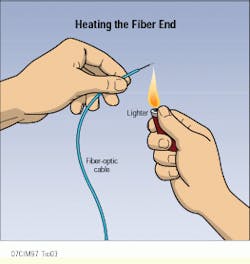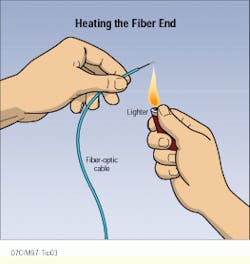Lighter serves as temporary replacement for fiber cleaver
Steve Wolszczak,
Wavetek Corp.
Problem
When testing unterminated fiber-optic cables, it is customary to use a temporary mechanical splice to connect the bare fiber to a test instrument, such as an optical time-domain reflectometer, light source, or power meter. But what happens if your fiber cleaver is unavailable or broken? You could rely on a hand scribe--a small tungsten or sapphire scribe that many fiber- optic technicians carry for backup. But what if you don`t have one?
Solution
A butane lighter will help you get the job done.
Procedure
1) Run the flame from the lighter under the piece of fiber to be spliced, causing stress cracking at the surface (probably because of the uncontrolled heating and cooling). The purpose of scribes and cleavers is to induce a crack.
2) Draw the heated fiber over a very gentle bend, such as your thumb. Keep the bend limited to about 20o. At this point, the fiber will break, usually leaving a break that is flat enough for temporary splicing and testing.
This method is not recommended for permanent splicing because it will cause multiple cracks, and reliability of the fiber in the heated area is suspect (but it works in an emergency). Be more careful using this method because it is easy to break off small pieces of the fiber inside the splice.
Editor`s note: Special care should be taken to ensure that fiber splinters do not pierce the skin, and that all fiber fragments are properly disposed of (see "Working safely when terminating fiber-optic cable," June 1996, page 51).
Strip back the jacket from the end of the fiber to be spliced, and heat the end with an ordinary butane lighter.
Steve Wolszczak is a product marketing manager for telecommunications products at Wavetek Corp. (Indianapolis, IN).

